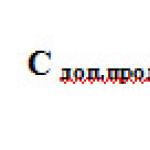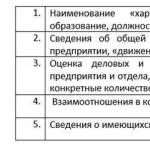Sample staffing table 3. Staffing table. To introduce a new position you must
The staffing form has its own specific filling requirements. Find out whether it is possible to do without the unified T-3 form and download an example of filling out the form and T-3 staffing forms in Excel and Word.
Read our article:
What information does the unified staffing form T-3 contain?
Since 2013, unified document forms have ceased to be mandatory, but many employers continue to use them. This is because they are familiar, convenient and fully comply with legal requirements. And if necessary, the employer can always supplement them with the necessary data.
The T-3 staffing form is required for the employer (Article 57 of the Labor Code of the Russian Federation). The SR is approved by order of the manager, and its validity period is not limited. The schedule ceases to be valid from the moment a new document is issued.
“Shtatka” is a convenient mechanism for analyzing the composition of personnel and the wage fund. It reflects not only occupied positions, but also vacant ones. The form is drawn up for the entire organization as a whole (including separate divisions and branches).
We will consider in detail the T-3 staffing form and a sample of its completion for 2018.
Conventionally, the document can be divided into 3 parts:
- basic information (document details);
- tabular part (directly staff);
- signatures of those responsible.
Read also:
Basic information
First of all, form No. T-3 indicates the name of the company, which must exactly correspond to the constituent documents. Indicating, for example, a trademark is unacceptable. If the company has an abbreviated name, it is indicated in brackets.
OKUD code is the document form number from the general classifier of unified documents. There is no need to change it; it is the same for all employers.
OKPO code - organization code. It can be found in the information letter from the statistics authorities. Such a letter is usually kept in the folder with the constituent documents. If you cannot find it, check with the chief accountant.
“Document number” detail. Here you can use continuous numbering, which is convenient for companies that rarely change the “staff”. With this option, the initial document is assigned number 1, the next one 2, and so on, regardless of the year.
Applying numbering within the current year, and starting everything next year from No. 1, is another option. It is convenient when throughout the year.
The current date is entered. The validity period of the document can be for different periods, depending on the needs of the company (month, six months, year).
The unified form T-3 staffing is approved. Only the details of the document are entered on its form. Below is the total number of staff positions from the tabular form.
Read also:
Tabular part of the staffing table

The tabular part of the T-3 form consists of 10 columns. The number of lines directly depends on the number of positions. It is most convenient to group by structural divisions, and within divisions - by hierarchy. This is the fastest way to find the required string.
Column 1. Name of the structural unit. It is more convenient to form the arrangement of structural units along lines according to the principle of subordination - from the upper levels of management to the working personnel. For some preferential professions, the name of the department (workshop, etc.) is of no small importance. If the name is incorrect, the employee may lose certain benefits. Therefore, when naming departments, refer to industry classifiers.
Column 2. Code. It is assigned by the employer independently and reflects the subordination of departments within the company. If structural unit 015 contains subordinate elements, they will be numbered 015.01, 015.02, etc.
Read also:
Column 3. Job title. The employer decides independently what to call this or that position. But if such a position is included in the list of “preferential” ones, then it must correspond to the normative name. If the employee’s specialty includes a rank, each rank is written on a separate line (concrete worker 2nd rank, concrete worker 3rd rank, ..., concrete worker 7th rank).
Column 4. Number of staff units. Both the actual number of workers in a given specialty and the projected number required by the company for normal functioning or with the prospect of development can be indicated. Thus, vacant positions are also reflected in this column.
If necessary, it is possible to use not only integer, but also fractional values. This is necessary when the employee is not required full-time. Most often, fractional rates are given to part-time workers. In SR this is displayed as: 0.5; 0.25; 0.75 bet.
Every entrepreneur who recruits employees knows that the enterprise must have staffing table T-3- a sample of filling out, the form should be on hand for every head of the personnel department.
Staffing is a document drawn up by a representative of the HR department, which describes the structure of the enterprise by departments, positions, number of employees, as well as the salaries that are provided for them. The staffing table can also be drawn up by an accounting employee. In any case, it must contain the visas of the top officials of the enterprise - its manager and, of course, the head of the accounting department. This document is not drawn up in a free form, but in a special one. The law defines the T-3 form for it.
In addition to the information indicated above, it should record the permissible combinations of positions, as well as the allowances provided for this. As a rule, they range from half to the full amount of the payment that is given to employees for the work done.
Staffing table T-3 must be adjusted and reviewed at least once a year in order to index all salaries. Please note that when filling out the T-3 form, you must fill out the same one twice. One copy is left to the head of the enterprise, the other to the chief accountant.
Filling out the staffing form
At the beginning of the T-3 staffing form, the name of the organization is written, and it must coincide to the letter with what is indicated in the constituent documents. Next, indicate the document number and the date when the staffing table was drawn up, as well as the time it entered into legal force. Also in the corresponding column is the period during which it will be valid. On the right side of the form there is a special column called “APPROVED”, in which the date and number of the order for the enterprise is written down. approved the staffing table for T-3. Please note that the number of employees is always indicated in numbers.

Next, the form has a table that also needs to be filled out. The first two columns indicate the code and name of the structural unit. In the next two - the position, based on the Classifier of Occupations, as well as the number of employees on staff that are provided for this position. The sixth, seventh and eighth columns are reserved for notes on employee incentives - the rate for overtime, the bonus given for working conditions that are recognized as harmful, etc. The ninth column should reflect the monthly salary fund. The tenth column is reserved for indicating additional data that may be contained in the T-3 Staffing Schedule - a sample for filling out, the form must be in the HR or accounting department.
The main document in the organization, which determines the list of professions used and the number of workers required to carry out the company’s business activities, is the staffing table. It is used as a basis when forming a company’s staff and determines its monthly costs for the use of labor resources. A sample staffing schedule can be downloaded below.
The staffing form is developed by competent specialists based on the existing staffing needs and is used in planning. As the enterprise operates, the data in this document may change, that is, new positions are introduced and unused positions are eliminated. Wages are also being adjusted.
Basically, this document is valid for one year, and is revised at the beginning of a new year. Labor legislation does not establish the mandatory nature of this regulatory act of the company. The company has the right to use an independently developed form, or use the staffing table, Form T 3, approved by the State Statistics Committee. Many specialized programs contain exactly this.
This document, after approval, is approved by order of the manager, who puts it into effect. Subsequently, the form is used by the personnel department, which, when concluding employment contracts, takes the salary amounts and its components from this document.
The sample staffing schedule of the enterprise must be available for review by all employees.
Sample of filling out the staffing table
Let's take a closer look at the staffing schedule and sample filling.
Form T3 must contain the name of the company, as well as its registration code with the statistical authorities (OKPO). Next, its number is entered, which is assigned to it taking into account the current numbering order, as well as the date of registration.
The date on which this provision comes into force is indicated below.
On the right, a record is made about the approval of the staffing table, that is, the number and number of the order for the main activity on entry and the total number of employees required to carry out the activity are filled in.
The main part of the document is presented in table form.
IN column "Structural division" The name of the corresponding department of the company is recorded according to the existing organizational structure, as well as its designation code, if a coding system is used. As a rule, it is either a set of numbers or abbreviations of the name of a structural unit. It may also contain a location designation.
IN column "Position" the names of specialties, positions, etc. are indicated.
When filling out the document, it is advisable to group professions within each division into blocks. It is advisable to write down the job title in accordance with OKPDTR. Legal entities in the public sector must definitely use this directory, and also include the rank and class of the employee in this column. This also applies to activities with dangerous and harmful working conditions, since this information is important when calculating preferential length of service.
IN column “Number of staff units” you need to record the number of workers for each profession. If the enterprise employs part-time workers and a part-time rate is provided for them, then this indicator can be written using decimal fractions, for example - 0.5. If a position in a company is vacant, it must still be indicated and taken into account. In this case, a record of the availability of a vacancy is made in the last column, or a footnote is included at the bottom of the staffing table.
The column “Salary” indicates the monthly wage, which is subsequently indicated in the concluded contracts with employees.
Next are columns with empty headings, united by the general name “Allowances”. In this section it is necessary to fill out all additional payments provided for in the Regulations on Remuneration for harmfulness, professionalism, intensity, special working conditions, as well as bonuses that are paid on a regular basis, etc.
The “Total” column represents the total amount for columns 5-8, multiplied by the number of employees in each profession.
IN column "Note" If necessary, explanatory information is indicated (about available vacancies, applicable work schedules, calculation rules, etc.).
The table ends with a summary line that summarizes the indicators for each column.
The document is endorsed by the chief accountant and personnel officer with a breakdown of their positions and personal data.
An example and form of the staffing table is given below.
The procedure for making changes to the staffing table
As a result of the company’s economic activities, additions and changes may be made to the staffing table by appropriate order of the manager.
If the document adjustments are significant, then it is recommended to approve a new staffing table with the following number and a certain period of validity. When changes affect existing personnel (salary increase, position renaming, etc.), then after the publication of a new document it is necessary to draw up appropriate additional agreements with the company’s employees.
It can conclude both civil and labor contracts with its employees. Article 57 of the Labor Code of the Russian Federation calls the indication “work according to the position in accordance with the staffing table” a mandatory condition of an employment contract. When drawing up a simplified staffing table for individual entrepreneurs, an example of which we will consider below, we recommend using the unified form No. T-3, approved by Resolution of the State Statistics Committee of Russia dated January 5, 2004 No. 1.
What is staffing and why is it needed?
The staffing table is an internal document by which an individual entrepreneur approves the structure, number of his full-time employees and their wages in accordance with their position.
An entrepreneur can develop the form of the document himself, but it is easier to use the unified form No. T-3. Its main sections include:
- name of the structural unit (department, workshop, etc.),
- employee position (the position specified in the employment contract must correspond to the position in the staffing table),
- the number of staffing positions provided for each position,
- salary or tariff rate (depending on the accepted form of remuneration),
- the effective date of the schedule.
The names of the employees filling the positions are not indicated in the schedule; they are appointed by order after the staffing has been approved. An individual entrepreneur should not include himself in the staffing table, since according to the Labor Code he is not an employee. The schedule is approved and put into effect by order signed by the entrepreneur.
The law does not contain a direct requirement for all employers to draw up a staffing table, but in practice it is better not to neglect this important personnel document. And that's why:
- Without an approved staffing table, it is impossible to reduce staff and dismiss employees under clause 2 of Art. 81 Labor Code of the Russian Federation;
- The staffing table or extracts from it are often requested during audits by tax authorities and extra-budgetary funds, and the labor inspectorate;
- the absence of a staffing table threatens the entrepreneur with a warning or a fine.
Sample staffing table 2018
Let's look at how to fill out the staffing table for individual entrepreneurs in a simplified manner. An example of a schedule adopted and in effect in 2018 is given below.
Unified form T 3 is a unified form of staffing, that is, a document that determines the personnel structure of the organization, including the hierarchy and number of positions, as well as payment for each position. You can download the T 3 staffing form from this article.
Read in the article:
It will be useful to HR department employees who develop the “staff”, as well as accountants - to justify tax benefits and prove the validity of expenses.
Staffing: form T 3
The staffing table is a local act that presents in summary form the division of labor in the company. It is compiled by the HR department for the entire organization as a whole, taking into account the organization’s immediate plans for hiring personnel based on existing needs and production tasks.
The Labor Code does not oblige every company to draw up such a document. But it is still desirable to have a staffing table so that the organization and the accounting department always have up-to-date data on:
- current number of employees and composition of vacant positions;
- wage fund for any period of time;
- compliance of the company's personnel structure with its strategy and development prospects.
Also, if there is a staffing table, it is easier for an accountant to confirm tax benefits and prove the validity of expenses for tax purposes.
As a rule, employees are hired after the approval of the company’s local documents. Therefore, in contracts, work books and other personnel documents, job titles and salary amounts must strictly correspond to the positions of the staffing table. Otherwise, employees will face difficulties in receiving government social, pension and medical payments.
Unified form T 3 staffing table
Since 2013, commercial firms and entrepreneurs have a choice when organizing document flow: use standardized forms or independently develop and approve their own forms. It is only important to include in them all the details required for the “primary” and provided for in Art. 9 of the Law of December 6, 2011 No. 402-FZ.
The problem of choice also affected personnel documentation. Now organizations have the right:
- or use the staffing table form T-3, if it is approved by the manager separately or as part of the accounting policy;
- or use a form developed independently and approved by the manager.
The unified staffing form looks like this:
Download the staffing schedule for free
Staffing form T-3 sample filling
There are not many staffing requirements. Firstly, in order to avoid violations of labor laws, the same salary is established for positions with labor tasks of the same complexity. After all, pay should be equal for work of equal value. Secondly, if within the same specialty there are different complexity and responsibility of the work, the scope of rights and responsibilities, then the job titles should reflect these differences. For example, you can use the words “senior”, “junior”, “leading”, etc.
The compiled “staff” is signed by the chief accountant and the HR employee. If the company is large and the document takes up several sheets, then the chief accountant can sign at the end of the document and on each sheet.
The head of the organization must approve the new “staff” by order. There is no unified form of the order; the company draws it up according to its own rules. A mandatory requirement is that the order must contain the date from which the staffing schedule is valid. The date may differ from the day on which the order was issued, or it may be the same.
Anything in the staffing table should be changed only as the personnel situation changes. If it is stable, there is no need to revise the document every year. The period of validity of the "staff" is not limited.
Structural divisions of companies do not need to draw up their own staffing schedule. An extract from the approved staffing table or a copy thereof is sent to divisions and branches.
It is not necessary to communicate the contents of the “staff” to employees, since the document does not regulate labor activities. Personnel information that concerns a specific employee is learned from his employment contract. But the obligation to familiarize staff with the staffing table may be established, for example, by a collective agreement





